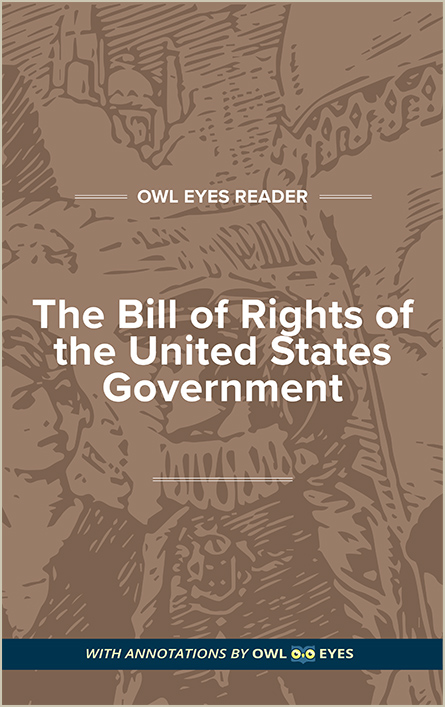Analysis Pages
Historical Context in The Bill of Rights
The American Revolution: The most significant historical event preceding the drafting of the Bill of Rights was the American Revolution. After the American colonies had operated under the thumb of Great Britain for nearly two centuries, colonists began to grow irritated by the strict governance, high taxes, and military presence of the British. In 1774, the Continental Congress, a council of representatives from the thirteen colonies, met for the first time to envision a new nation, raise an army, and launch a revolt. In 1776, the Revolutionary War was underway and the Continental Congress declared their independence. By 1778, the war was won, and the new United States of America started to build towards a shared dream of a democratic nation.
The Articles of Confederation and the Constitution: When the Continental Congress gathered in the late 1770s, one of their objectives was to forge a provisional government code. This code would allow them to function as a legislative body, field an army to fight for independence from Great Britain, and conduct trade with other nations. This provisional code, finalized in November of 1777, was known as the Articles of Confederation. After the victory against Great Britain, the Continental Congress continued to meet, but with a new aim: to craft a more lasting system of government. These founding statesmen created a three-part structure: the executive branch, helmed by the president; a legislative branch, balanced between the Senate and the House of Representatives; and a judicial branch, guided by the nine justices of the Supreme Court. This new system became the United States Constitution and was passed and brought into existence in 1787.
The Federalists and the Anti-Federalists: In the drafting of the Constitution, there were two distinct groups of politicians. The Federalists, led by Alexander Hamilton, John Adams, and James Madison, favored a stronger federal government than had existed under the Articles of Confederation. They wanted provisions such as a powerful president and a national bank. The Anti-Federalists, led by Patrick Henry, Samuel Adams, and George Mason, wanted to downsize the power of the federal government and provide more rights to states and individual Americans. The Anti-Federalists voted against the Constitution and pushed for the inclusion of a Bill of Rights in order to empower individual citizens in the face of a strong federal government. In 1791, the Bill of Rights was successfully ratified and added to the Constitution.
The Bill of Rights in Practice: For the first century after the passing of the Bill of Rights, its amendments were, generally speaking, not of great legal importance. The rights set forth in the Bill of Rights applied only to the federal government, and for most of the 19th century it was not clear whether the states or the federal government had the chief power to pass and enforce laws. Only after the passing of the Fourteenth Amendment in 1868 did this begin to change. The Fourteenth Amendment allowed for a new process known as “incorporation,” whereby Constitutional laws were incorporated into state and local governments. In the last 150 years, the amendments stipulated in the Bill of Rights have been the source of a series of significant Supreme Court decisions, which have further and further elucidated the role of the Bill of Rights in American life and law.
Historical Context Examples in The Bill of Rights:
The Preamble to the Bill of Rights
🔒"pursuant to the fifth Article of the original Constitution...." See in text (The Preamble to the Bill of Rights)
"the following Articles be proposed to the Legislatures..." See in text (The Preamble to the Bill of Rights)
"in order to prevent misconstruction or abuse of its powers..." See in text (The Preamble to the Bill of Rights)
"a number of the States..." See in text (The Preamble to the Bill of Rights)
"beneficent..." See in text (The Preamble to the Bill of Rights)
"the ground of public confidence in the Government..." See in text (The Preamble to the Bill of Rights)
"at the City of New York..." See in text (The Preamble to the Bill of Rights)
"one thousand seven hundred and eighty nine...." See in text (The Preamble to the Bill of Rights)
"on Wednesday the Fourth of March..." See in text (The Preamble to the Bill of Rights)
The Ten Original Amendments to the Constitution of the United States
🔒"Amendment X ..." See in text (The Ten Original Amendments to the Constitution of the United States)
"Amendment IX ..." See in text (The Ten Original Amendments to the Constitution of the United States)
"Amendment VIII..." See in text (The Ten Original Amendments to the Constitution of the United States)
"Amendment VII..." See in text (The Ten Original Amendments to the Constitution of the United States)
"Amendment VI..." See in text (The Ten Original Amendments to the Constitution of the United States)
"nor be deprived of life, liberty, or property..." See in text (The Ten Original Amendments to the Constitution of the United States)
"Amendment IV..." See in text (The Ten Original Amendments to the Constitution of the United States)
"Amendment III..." See in text (The Ten Original Amendments to the Constitution of the United States)
"Amendment II..." See in text (The Ten Original Amendments to the Constitution of the United States)

